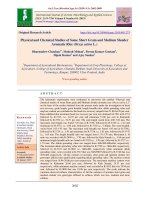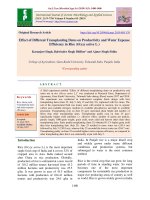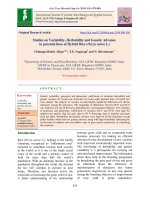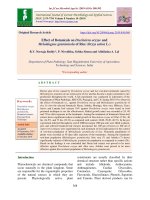Evaluation of allelopathic potential of some Vietnamese rice (Oryza sativa L.) landraces against the growth of barnyardgrass (Echinochloa crus Galli p. beauv) in the laboratory condition
Bạn đang xem bản rút gọn của tài liệu. Xem và tải ngay bản đầy đủ của tài liệu tại đây (340.42 KB, 8 trang )
94
Ha Noi Metroplolitan University
EVALUATION OF ALLELOPATHIC POTENTIAL OF SOME
VIETNAMESE RICE (ORYZA SATIVA L.) LANDRACES AGAINST THE
GROWTH OF BARNYARDGRASS (ECHINOCHLOA CRUS-GALLI
P. BEAUV) IN THE LABORATORY CONDITION
Nguyen Nhu Toan1, Khuat Huu Trung2, Dao Xuan Duc2,
Tran Dang Khanh2*, Nguyen Truong Giang3, Nguyen Lam Phuc4
1
Hanoi Metropolitan University
2
Agricultural Genetics Institute
3
Department of Science Technology and Environment - Ministry of Agriculture
and Rural Development
4
University of Science - Hanoi National University
Abstract: Allelopathy is a biological phenomenon by which an organism produces one or
more biochemicals that influence the germination, growth, survival and reproduction of
other organisms. In plants, Allelopathy can simply be comprehended as the ability of
plants to inhibit or stimulate the growth of vicinity plants in nature. The objective of this
study was to evaluate the allelopathic potential of 20 Vietnamese rice landraces against
the growth of barnyard grass (Echinochloa crus-galli) in laboratory condition. The
results showed that allelopathic activity of the rice showed landrace – dependence and
origin dependence. All rice landraces showed significant average inhibition on the shoot
and root length of barnyardgrass 17.71%, and 58.67%. Typically, the highest
suppressing the shoot length was G170 OM504-JP (30.19%), followed by G423 N22
(29.49%) and G22 Tr. Trang (29.67%). For the root length inhibition, the maximum
suppression was found HT9 (65.96%), while the lowest inhibition was Ble Blaudo
(43.0%). Generally, the rice landraces used in this study revealed the remarkable
inhibition over 50.0%. The results of this study might provide useful information for
improving the weed-suppressing ability of rice in this country.
Keywords: Allelopathy, barnyard grass, landrace, rice
Email:
Received 21 October 2019
Accepted for publication 25 November 2019
1. INTRODUCTION
Rice (Oryza sativa L.) is the main crop and is providing daily food for over half of
world population. Vietnam has been ranked as one of the second-biggest rice exporters in
Scientific Journal No35/2019
95
the world. According to the report of MARD (2016) [1], 4.88 million tons of rice was and
exported and earned 2.2 billion USD. However, rice export volume has decreased by
27.0% similar with reduction of rice export turnover by 22.0% to compare with the year
of 2016.
Currently, rice crop in Vietnam has encountered biotic and biotic factors, leading to
low rice yield compared to other rice-producing countries. Among the adverse factors,
weed infestation is a major biotic constraint and one of the biggest challenges to rice yield
in Vietnam. Causing severe economic losses. In the Mekong Delta, weeds cause over 46%
rice yield losses on average in direct-sowing rice areas [2, 3]. Traditional weed
managements in Vietnam are hand-weeding, water management, land preparation and
sowing/seedling techniques. All these methods are dependent on weather conditions, are
time-consuming and require intensive labor. Following urbanization and economic growth,
a decrease in the labor force in the agricultural sector is occurring in Vietnam, causing a
rapid increase in pesticide and herbicide uses [4]. Herbicide utilization can minimize the
time spent on weed control and stabilize the rice yield. However, the overuse of synthetic
chemicals for weed control is a serious problem in Vietnam, causing environmental
pollution, unsafe agricultural products and human health concerns [2, 5].
Biological control of weeds in rice is somewhat less known and has carried out
sporadically in this country [6]. Therefore, reducing the dependency on synthetic
herbicides and agrochemicals in agricultural production in Vietnam is an important task to
develop environment-friendly and maintain sustainable agricultural production.
Alleopathy or weed suppressing of host plant can be known as both beneficial and
deleterious biochemical interactions between plants and microorganisms via the secondary
metabolites that release into the environment and cause influence on the growth and
development of vicinity plants [7].
Exploitation of allelopathy can improve crop production via avoidance of negative
impacts, exploitation of stimulatory effects management and development of allelopathic
crops and cultivars to suppress weeds as well as utilizing plant growth inhibitor as nature
herbicides [6]. In another hand, biological weed management by using allelopathy may
affect a yield improvement without environmental cost, which is one of the most important
considerations for this country. Therefore, the objective of this study is to evaluate
allelopathy potential of the 20 selected Vietnamese rice landraces in laboratory condition.
The result may provide useful information to further develop rice allelopathy for
sustainable agriculture production in this country.
96
Ha Noi Metroplolitan University
2. MATERIALS AND METHODS
2.1. Preparation of rice landraces and barnyard grass seeds
Twenty rice landraces were kindly provided by Vietnam Plant Resource Center in
2017 as shown in Table 1. Barnyard grass seeds (Echinochloa crus-galli P. Beauv. Var
oryzicola Ohwi) were grown and harvested at Agricultural Genetics Institute (AGI) - Lai
Yen Experimental Station in 2018.
Table 1: List of the 20 Vietnamese native rice landraces used in this study
No
Rice landraces
No
Rice landraces
1
Ble Blau do
11
G223 Pok
2
Bulu Pan dark
12
Lua den
3
G170 OM504
13
Nep tu le
4
G423 N22
14
G168 OM1490
5
Huong Chiem
15
G45 Nep cuc
6
G22 Tr.Trang
16
HT9
7
G133 A330
17
G59 nep man
8
Nep TTHP
18
SH8
9
GL 106 (GL)
19
BT09
10
G176 K.B.Duong
20
J022
2.2. Bioassay
The empty and undeveloped seeds were discarded by floating in tap water. The
remaining seeds were air-dried and then hermetically stored at -20◦C. Before conducting
the experiment for breaking of dormancy, both rice and barnyardgrass seeds were
incubated at 40◦C for five days. Before use in the bioassay, barnyardgrass seeds were
sterilized with 1% sodium hypochlorite for 30 sec and rinsed several times with distilled
water. In the germination test, the germination ratio of seeds was randomly checked and
showed to be more than 90%.
A total of 20 Vietnamese rice landraces were screened in the laboratory for their
allelopathic potential against barnyardgrass. Twenty healthy seeds of each rice landraces
were evenly sown in a Petri dish (9 cm diameter) lined with filter paper and added to 10 ml
of distilled water. Simultaneously, 20 seeds of barnyardgrass were evenly inter-planted
between the rice seeds (Figure 1). The Petri dishes were transferred into a growth chamber
(25◦C, 4000 lux, lighted time: 9:00-17:00h; humidity: 75%). After seven days. The
Scientific Journal No35/2019
97
numbers of germinating barnyardgrass seeds were counted and the length of shoots and
roots was measured. Additionally, the inhibition percentage (%) between treatment and the
control was calculated by the equation:
Inhibition (%) = [(control-rice variety treatment)/control] x 100
The inhibition magnitudes against barnyardgrass growth including the SL, DW of the
sampled barnyard grass were recorded as an average inhibition (AI).
Figure 1: Diagram of seed distribution in a Petri dish
2.3. Statistical analysis
The experiments in laboratory screening were done in a completely randomized design
with 3 replications. Statistical analysis was performed using analysis of variance to analyze
treatment differences [9]. The means were separated on the basis of the least significant
differences (LSD) at the 0.05 probability level.
3. RESULTS AND DISCUSSION
In the current study, barnyard grass was selected as the indicator plant because it is
one of the most noxious paddy weeds available grown in upland and lowland paddy fields
in Vietnam and caused rice yield significant reduction and troublesome to farmers.
In this study, the selected 20 Vietnamese rice landrace were used to assess their
allelopathic properties on the growth of barnyardgrass. For the average of the shoot and
root length inhibition, most of the rice landraces showed the inhibition on the growth of
barnyardgrass was 17.71%, and 58.67%, respectively. The highest suppressing the shoot
length was G170 OM504-JP (30.19%), followed by G423 N22 (29.49%) and G22
Tr.Trang (29.67%). It noted that 9 rice landraces reduced the shoot length of barnyardgrass
98
Ha Noi Metroplolitan University
by over 20% including: Lua den (28.73%), G133A330 (27.98%), G168 OM1490
(24.60%), HT9 (24.25%), Bulu Pan dark (22.28%), G223 Pokkali (21.40%), G176
K.B.Duong (20.88%), JO2 (20.48%), respectively. There were 8 rice landrace showing the
shoot length inhibition less than 20% as following: Nep Tu le (16.75%), BT09 (16.87%),
SH8 (13.67%), G45 nep cuc (13.14%), nep TTHP (12.21%), G59 nep man (12.15%),
Huong chiem (10.93%). Only the Ble Blaudo landrace was found to be promoted the shoot
length of barnyardgrass by 32.46% (Table 2).
Table 2: Allelopathic potential of the 20 selected Vietnamese rice landraces
on the growth of barnyardgrass in the laboratory condition
No
Rice landraces
Shoot length
(cm)
Shoot length
inhibition
(%)
Root length
(cm)
Root length
inhibition
(%)
1
Ble Blau Do
7.95
-32.46
3.26
43.00
2
Bulu Pan dark
4.45
22.28
2.28
60.08
3
G170 OM504
4.00
30.19
1.99
65.15
4
G423 N22
4.04
29.49
2.35
58.85
5
Huong Chiem
5.10
10.93
2.56
55.24
6
G22 Tr.Trang
4.03
29.67
1.96
65.79
7
G133 A330
4.13
27.98
2.05
64.04
8
Nep TTHP
5.03
12.21
2.87
49.70
9
GL 106 (GL)
5.09
11.11
2.98
47.90
10
G176 K.B.Duong
4.53
20.88
2.13
62.64
11
G223 Pok
4.50
21.40
2.07
63.81
12
Lua den
4.08
28.73
2.06
63.98
13
Nep tu le
4.77
16.75
2.48
56.64
14
G168 OM1490
4.32
24.60
2.83
60.01
15
G45 Nep cuc
4.98
13.14
2.59
54.72
16
HT9
4.34
24.25
1.95
65.96
17
G59 nep man
5.03
12.15
2.06
63.86
18
SH8
4.95
13.67
2.25
60.60
19
BT09
4.76
16.87
2.33
59.20
20
J022
4.56
20.48
2.74
52.09
Control
5.73
0.0
5.72
0.0
Total inhibition
4.71
17.71
2.36
58.67
LSD (0.05)
0.72
Note: (-) implies the promotion of barnyargrass’s growth
0.91
Scientific Journal No35/2019
99
For the root length inhibition, all rice landraces showed a significant inhibition over
40.0%, ranged from 43.0% to 65.79%, respectively. The maximum suppression was found
HT9 (65.96%), while the lowest inhibition was Ble Blaudo (43.0%). Generally, the rice
landraces used in this study revealed the remarkable inhibition over 50.0% as the order:
HT9 (65.96%), G22Tr.trang (65.79%), G170 OM504 (65.15%), G133 A330 (64.04%),
Lua den (63.98%), G59 nep man (63.86%), G223 pok (63.81%), G176 K.B.Duong
(62.64%), SH8 (60.60%), G168 OM490 (60.01%), BT09(59.20%), G423 N22 (58.85%),
Nep tu le (56.64%), Huong Chiem (55.24%), G45 nep cuc (54.72%) and J022 (52.09%),
respectively (Table 2).
For average inhibition on the growth of barnyardgrass, there are 10 rice landraces
showing suppressing ability over 40.0%, of which the highest suppression of barnyardgrass
growth was found in G22 Tr.Trang (47.73%) and G170 OM504 (47.67%), respectively.
Eight rice landraces showed average inhibition on the growth of barnyardgrass by over
30.0% were as the order: BT09 (38.04%), G59 nep man (38.01%), J022 (36.92%), Nep Tu
le (36.70%), G45 Nep cuc (33.93%), Huong Chiem (33.09%) and Nep TTHP (30.96%),
respectively. The weakest allelopathic average inhibition was found in Ble Blaudo
(5.72%), followed by GL 106 (GL) (29.51%), respectively (Figure 2).
Figure 2: The average inhibition of the 20 selected rice landraces against
the growth of barnyardgrass
100
Ha Noi Metroplolitan University
In some last years, many works have been carried out to evaluate allelopathic potential
of rice in field condition. Dil day et al (2000) [10] reported 412 among 12.000 rice
landraces displayed alleopathic activity against duck salad in-field evaluation. So far,
thousands of rice landraces have been assessed their alleopathic activity. The results
showed that germplasm from china and Japonica rice landraces had more allelopathic
potential than other rice varieties [11]. Recently, 73 landraces with different varietal groups
against the growth of barnyard in laboratory, greenhouse and field conditions were
evaluated. It showed that hybrid variety showed highest inhibition than non-sticky
varieties, followed by foreign and traditional sticky rice varieties. The lowest inhibition
was found in upland sticky rice varieties [6]. Allelopathic rice landraces have been induced
by many allelopathic chemicals which were previously reported involving in numerous
phytotoxins such as phenolic acids, diterpenoids, glucopyranosides, momilactones, oryzaexin,
and stigmastanols etc. were isolated from the leaf, stem, root and root exudates [5].
It was similar with our current work because most rice landraces used in this study
were traditional and upland rice landrace with the exception of G170 OM504, G168
OM1490, J022 and HT9 is the improved rice varieties which exhibited allelopathic
property rather high than other landraces.
4. CONCLUSIONS
In summary, the 20 selected rice landraces were evaluated the allelopathic allelopathic
potential in laboratory condition. Rice allelopathy activity showed landrace - dependence
and origin – dependence. All rice landraces showed remarkable weed-suppressing on the
growth of barnyardgrass. Further research on assess the allelopathic properties of those
landraces should be conducted in the greenhouse and field conditions as well as isolating
allelochemicals which may be responsible for weed inhibition ability. The current results
might be useful for the improvement of the weed-suppressing ability of rice in this country.
Acknowledgement: Authors would like to thank Miss Dang Thi Mai Huong for her
efforts to contribute to this experiment.
REFERENCES
1.
MARD - Ministry of Agriculture and Rural Development (2016), Annual report of rice
production. December. 2016.
2.
Chin. D.V. (2001), “Biology and management of barnyard grass. Red sprangletop and weedy
rice”- Weed Biology and Management. 1:37-41.
3.
Khanh T.D., Xuan T.D., Chin D.V., Chung I.M., Abdelghany E.A., Tawata S. (2006),
“Current status of biological control of paddy weeds in Vietnam”- Weed Biology and
Management. 6:1-9.
Scientific Journal No35/2019
101
4.
Khanh T.D, Linh L.H, Linh T.H, Quan N.T, Trung K.H, Cuong D.M, Hien V.T.T; Ham L.H,
Xuan T.D (2013), “Integration of allelopathy to control weeds in rice. In: Herbicides” –
Current Research and Case Studies in Use. Andrew. J (eds). 75-99.
5.
Khanh T.D. Xuan T.D, Chung I.M. (2007), “Rice allelopathy and possibility for weed
management”- Annals of Applied Biology. 151:325-339.
6.
Khanh T.D, Cong L.C, Chung I.M, Xuan T.D (2009), “Variation of weed-suppressing
potential of Vietnamese rice cultivars against barnyard grass (Echinochloa crus-galli) in
laboratory”- Greenhouse and field screenings. Journal of Plant Interactions. 4:209-218.
7.
Rice E.L., (1984), Allelopathy.2nd ed. Academic Press Inc. Orlando. FL; p.422.
8.
Ahn J.K, Hahn. S.J, Kim. J.T, Khanh. T.D, Chung. I.M. (2005), Evaluation of allelopathic
potential among rice (Oryza sativa L.) germplasm for control of Echinochloa crus galli P.
Beauv in the field. Crop Protection. 24:413-419.
9.
SAS Institute. (1997), SAS/STAT User’s Guide. 6.12 Ed. SAS Institute. Cary.NC.
10. Dilday. R.H, Mattice J.D, Moldenhauer K.A. (2000), “Anoverview of rice allelopathy in the
USA” - In Proceedings of International Workshop in Rice Allelopathy. 17–19 August 2000.
Kyungpook National University.pp.15–26. Taegu. Korea: Institute of Agricultural Science and
Technology. Kyung-Pook National University.
11. Dilday R.H, Mattice J.D, Moldenhauer K.A, Yan A.W. (2001), “Allelopathic potential of rice
germp lasm against duck salad. Red stem and barnyard grass” - Journal of Crop Production.
4.287–301.
ĐÁNH GIÁ TIỀM NĂNG ALLELOPATHIC Ở MỘT SỐ LOÀI
LÚA CỦA VIỆT NAM CHỐNG LẠI SỰ PHÁT TRIỂN CỦA
LOÀI CỎ BARNYA TRONG ĐIỀU KIỆN PHÒNG THÍ NGHIỆM
Tóm tắt: Allelopathy là một hiện tượng sinh học, nó được sản sinh ra bởi sinh vật hoăc
điều chế sinh hóa học, nó có ảnh hưởng đến sự nảy mầm. Ở thực vật, allelopathy có thể
được hiểu một cách đơn giản nó như là khả năng của thực vật để ức chế hoặc kích thích
sự sinh trưởng của các loại thực vật gần nó. Mục đích của nghiên cứu này đã đánh giá
khả năng của allelopathic ở 20 giống lúa của Việt Nam chống lại sự phát triển của cỏ
barnyard (echinochloa crus-galli) trong điều kiện phòng thí nghiệm. Kết quả nghiên cứu
đã chỉ ra rằng allelopathic hoạt động ở lúa phụ thuộc vào điều kiện phát triển và phụ
thuộc vào nguồn gốc của nó. Tất cả các loài lúa bản địa cho thấy sự ức chế sự phát triển
chiều dài của chồi và rễ ở cây cỏ Barnya 17,71% và 58,67%. Điển hình, chiều dài của
chồi bị hạn chế cao nhất là G170 OM504 JP (31,19%), tiếp theo là G423 N22 (29,49%)
và G22 Tr.Trang (29,67%). Với sự ức chế chiều dài của rễ, sự ức chế tối đa đã được tìm
thấy HT9 (65,96%), trong khi sự ức chế thấp nhất là Ble Blaudo (43,0%). Nói chung, các
loại lúa địa phương được sử dụng trong nghiên cứu này đã cho thấy sự ức chế đáng chú
ý trên 50,0%. Kết quả của nghiên cứu này có thể cung cấp thông tin hữu ích để cải thiện
khả năng tiêu diệt cỏ của lúa ở Việt Nam.
Từ khóa: Allelopathy, cỏ barnyard, địa phương, lúa









